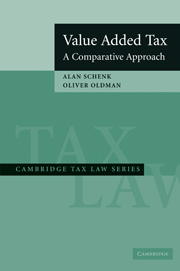Book contents
- Frontmatter
- Contents
- List of Tables, Figures, and Charts
- List of Cases
- Preface to the Revised Edition
- Value Added Tax
- 1 SURVEY OF TAXES ON CONSUMPTION AND INCOME, AND INTRODUCTION TO VALUE ADDED TAX
- 2 FORMS OF CONSUMPTION-BASED TAXES AND ALTERING THE TAX BASE
- 3 VARIETIES OF VAT IN USE
- 4 REGISTRATION, TAXPAYER, AND TAXABLE BUSINESS ACTIVITY
- 5 TAXABLE SUPPLIES OF GOODS AND SERVICES, AND TAX INVOICES
- 6 THE TAX CREDIT MECHANISM
- 7 INTRODUCTION TO CROSS-BORDER ASPECTS OF VAT
- 8 TIMING, TRANSITION AND VALUATION RULES
- 9 ZERO RATING AND EXEMPTIONS AND GOVERNMENT ENTITIES AND NONPROFIT ORGANIZATIONS
- 10 GAMBLING AND FINANCIAL SERVICES (OTHER THAN INSURANCE)
- 11 INSURANCE
- 12 INTERJURISDICTIONAL ASPECTS OF VAT IN FEDERAL COUNTRIES AND COMMON MARKETS
- 13 REAL PROPERTY
- 14 PROPOSALS FOR U.S. TAX ON CONSUMPTION
- APPENDIXES
- Index
3 - VARIETIES OF VAT IN USE
Published online by Cambridge University Press: 06 January 2010
- Frontmatter
- Contents
- List of Tables, Figures, and Charts
- List of Cases
- Preface to the Revised Edition
- Value Added Tax
- 1 SURVEY OF TAXES ON CONSUMPTION AND INCOME, AND INTRODUCTION TO VALUE ADDED TAX
- 2 FORMS OF CONSUMPTION-BASED TAXES AND ALTERING THE TAX BASE
- 3 VARIETIES OF VAT IN USE
- 4 REGISTRATION, TAXPAYER, AND TAXABLE BUSINESS ACTIVITY
- 5 TAXABLE SUPPLIES OF GOODS AND SERVICES, AND TAX INVOICES
- 6 THE TAX CREDIT MECHANISM
- 7 INTRODUCTION TO CROSS-BORDER ASPECTS OF VAT
- 8 TIMING, TRANSITION AND VALUATION RULES
- 9 ZERO RATING AND EXEMPTIONS AND GOVERNMENT ENTITIES AND NONPROFIT ORGANIZATIONS
- 10 GAMBLING AND FINANCIAL SERVICES (OTHER THAN INSURANCE)
- 11 INSURANCE
- 12 INTERJURISDICTIONAL ASPECTS OF VAT IN FEDERAL COUNTRIES AND COMMON MARKETS
- 13 REAL PROPERTY
- 14 PROPOSALS FOR U.S. TAX ON CONSUMPTION
- APPENDIXES
- Index
Summary
INTRODUCTION
Excluding VATs that are covered only tangentially in this book, such as those in effect in China, Russia, and excluding those in civil law, non-English-speaking countries outside the European Union (EU), most VATs imposed at the national level can be classified in four groups. The most prevalent form of VAT is the harmonized VAT in the EU member states. The EU model has the most extensive case law on VAT issues. More recent entrants to the VAT family have expanded the VAT base and made other significant changes. Other customs or common market communities may move to harmonize their indirect taxes in order to provide for the free movement of goods, services, and capital within the community.
New Zealand departed from the EU model in a number of significant ways, including the expansion of the tax base for its Goods and Services Tax (GST) by limiting exemptions and zero rating and by taxing many government services. South Africa modeled its VAT after the New Zealand GST, but included some of its own unique features. For example, South Africa taxes all fee-based financial services.
Canada has a national VAT (its GST) and several provinces have harmonized VATs. The combined Quebec-national GSTs are administered by Quebec. The combined national and maritime provinces GSTs (the Harmonized Sales Tax) are administered at the national level. The Canadian GST is discussed elsewhere in the book.
- Type
- Chapter
- Information
- Value Added TaxA Comparative Approach, pp. 58 - 72Publisher: Cambridge University PressPrint publication year: 2007
- 2
- Cited by



